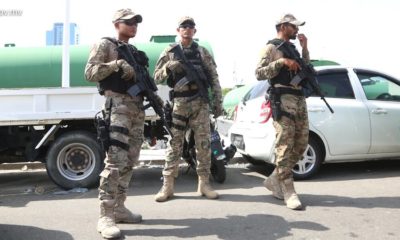The police have dampened speculation over the death of a Maldivian medical student in Bangladesh who was found hanged in her dorm room on March 29.
The family of Raudha Athif, 20, alleges that she was murdered by a fellow student at the Islami Bank College in Rajshahi.
But Chief Superintendent Mohamed Riyaz told the press Tuesday after returning from Bangladesh that there were “no suspicious circumstances” surrounding her death. Based on the findings of a two-member police team that travelled to Rajshahi, he also provided explanations for questions raised in the media.

Photo by Sotti
Raudha became a social media sensation with a viral photograph known as the ‘Maldivian girl with aqua blue eyes.’ She pursued modelling as a hobby and was featured on the October 2016 cover of Vogue India.
Her death gripped the nation with daily media updates during the past two weeks and rumours, debate and conspiracy theories on social media.
The speculation intensified when her family rejected an autopsy report conducted by three doctors at the Rajshahi Medical College Hospital that concluded that she committed suicide.
On Monday, her father Dr Mohamed Athif filed a case at the Rajshahi metropolitan court naming Raudha’s classmate Seerat Parvin Mohamed as the prime suspect. After examining evidence, the court reportedly ordered the police to launch a homicide investigation.
“I am certain my daughter was murdered. There were fingerprints around her neck. From the looks of these prints, Raudha was choked to death by a right-handed person,” Athif told reporters.
According to the family, other reasons for suspecting foul play include a cooked meal on her stove, indications of violence in her room, a broken security camera, and the lack of signs of forced entry.
“In such a situation, people would face something called fright reaction. They will try to bring down the door with a blow, but there were no such signs,” Athif previously told the Maldives Independent.
But Chief Superintendent Riyaz said the vertical lock could have been unlatched by shaking or repeated banging. College security personnel had also tried to open the door along with several students, he added.
He noted that students from four different nationalities were among those who tried to rescue Raudha. As there was no known personal animosity between them and Raudha, Riyaz said there was no reason to suspect that all of them conspired to kill her.
“On reports of a scene of violence found in the room, we discovered that the broken mirror on the wardrobe and the crack on the bed had existed days before Raudha’s death,” he said
“There were concerns over missing CCTV footage in the college. Our findings show that some of the CCTV cameras had not been functioning properly since March 25 due to low maintenance.”
Ligature marks around Raudha’s neck were possibly caused by “metal balls and nylon strings on two scarves which were knotted together” and used as a noose.
“We also found traces of dribbling saliva on Raudha’s clothing and the scarves,” Riyaz said.
Raudha’s father had previously flagged the absence of foaming at the mouth and insisted that the marks on her neck did not match the scarves.
Following Tuesday’s press conference, Athif accused the police of spreading “false news” and called it “a great injustice.”
Riyaz also revealed that the police questioned an unnamed person in Malé after information was uncovered from Raudha’s phone.
The phone was unlocked with the help of a student at the college who said Raudha had shared her password when it auto-locked while they were looking up recipes online.
Raudha had also borrowed a laptop of another Maldivian student and logged into someone else’s Facebook account, Riyaz said.
Last week, Bangladeshi police told the media that the contents of Raudha’s phone showed that she fought with her boyfriend on the night of her death.
But Athif dismissed the conversation as evidence supporting suicide. “Those were not unusual conversations. It shows that she was upset and unhappy about something. I am confident that my daughter is brave enough to face something like that,” he said.
Riyaz meanwhile stressed the lack of evidence to suspect Seerat Parvani, an Indian from Kashmir.
According to Athif, Raudha told her mother that Seerat had tried to drug her by putting sleeping pills in her juice while they were up studying one night.
The Bangladeshi police confiscated Seerat’s phone after the family’s allegations, which she has since denied.
Riyaz confirmed that Seerat, whose room was next to Raudha’s, was the first to see her hanged. Other students came when she raised the alarm, he added.
Some students also told the family that Seerat had accompanied Raudha to the hospital on the night of her death. But Riyaz said they went separately. Seerat also came back before Raudha, he said.
He also revealed that a Maldivian student was the last to see Raudha alive. She saw Raudha return from the hospital and enter her room.
Riyaz went on to confirm that some of her friends had unfollowed Raudha on Instagram in the days after her death, which became the basis of a widely shared conspiracy theory by a Maldivian blogger.
The Instagram account was later deactivated. Riyaz said the police are investigating the matter as the incident suggests attempts to “divert the focus” over Raudha’s death.
The investigation by the Bangladeshi authorities is also ongoing.
Raudha’s brother Rayyan Athif meanwhile told British tabloid The Sun last week that he believes his sister’s death was staged as a suicide.
“There have been a series of murders in Bangladesh which have been staged to look like suicides and Islamic extremists have been suspected to be behind these atrocities,” he was quoted as saying.
The 18-year-old said his sister’s style of clothing was “branded immodest and un-Islamic” although she adhered to the college dress code by wearing a headscarf to class.
 “But she was criticised for wearing jeans and was repeatedly told she couldn’t wear it at the Muslim college – which has a lot of extremist connections and support. Other students have also been subjected to this type of bullying,” he said.
“But she was criticised for wearing jeans and was repeatedly told she couldn’t wear it at the Muslim college – which has a lot of extremist connections and support. Other students have also been subjected to this type of bullying,” he said.
According to Bangladeshi media, the police and locals claim that many of the students and staff are supporters of Jamaat-e-Islami and Islami Chhatra Shibir, the student wing of the largest Islamist political party in the Bangladesh, which was de-registered in 2013 over its anti-democratic ideology.
Rayyan also contended that the two locks on the door could not have slipped down.
“We demonstrated it. We banged on the door and the locks didn’t move an inch. I would love an explanation for this,” he said.
Bangladesh’s The Daily Star meanwhile reported today that a five-member inquiry committee formed by the college has concluded that Raudha took her own life.
Insha Chisti, a third-year student, told the committee that she tried to untie the knot of Raudha’s scarf from the ceiling fan.
“Someone gave me a knife. I cut her scarf and got her down on the bed thinking her to be alive,” she said, according to the committee’s report.




 “But she was criticised for wearing jeans and was repeatedly told she couldn’t wear it at the Muslim college – which has a lot of extremist connections and support. Other students have also been subjected to this type of bullying,” he said.
“But she was criticised for wearing jeans and was repeatedly told she couldn’t wear it at the Muslim college – which has a lot of extremist connections and support. Other students have also been subjected to this type of bullying,” he said.

















